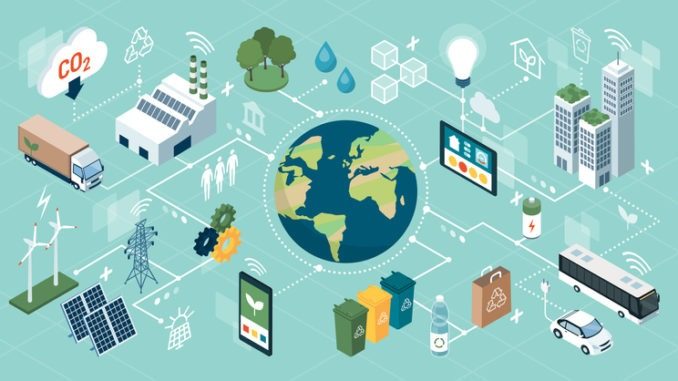
Sustainability stopped being just a buzzword a long time ago – it’s time to make a change, and schools can be an inspiration to the wider community by improving their green credentials through the procurement process
Why should schools reduce their carbon emissions?
- Saving energy saves money. Current school energy costs are estimated to increase to £652m per year, and this is predicted to rise still further. The average cost of energy per school is £27,000, although secondary schools can have bills of over £80,000 – double the amount spent four years previously. Case study evidence suggests that an average secondary school could save up to 20% off its energy bills through replacement of heating, lighting and cooling equipment.
- Many pupils have strong concerns about climate change, and they are right to do so. Current projections indicate that the impact of climate change will grow over the course of this century and it is them and their children, rather than present day adults, who will face the most significant impacts.
- Reducing emissions by adopting active modes of travel (cycling, walking) has significant health and wellbeing benefits, and helps reduce travel costs.
How much carbon do schools generate?
Schools account for around two per cent of UK greenhouse gas emissions, roughly the same as all the energy and transport emissions of Manchester, Newcastle and Bristol combined. This is equivalent to 15% of the country’s public sector emissions.
How do schools generate carbon?
Greenhouse gas emissions from the schools sector are divided into four main sources:
- Energy use in school buildings;
- pupil and staff travel to and from school, and other journeys undertaken on school business;
- emissions produced by companies that supply goods and services to schools – for example, a school food provider. This could include emissions related to their use of energy to run their buildings and produce their food products, as well as the emissions associated with transporting their products to school sites;
- emissions from waste produced by schools.
How can you change your procurement process to be more sustainable?
All procurement decisions will have some impact on sustainable development. A good procurement decision is one that evaluates these impacts in the same way that other procurement factors are evaluated. Initial cost, quality, durability, running costs, management and disposal issues all need to be assessed, and will all influence the final procurement decision.
Forty-two per cent of carbon emissions from the schools sector come from procurement – the day-to-day buying choices and decisions made by each school. This is nearly one per cent of total carbon emissions in the UK. So how can schools make their procurement process more eco-friendly?
Develop procurement expertise – nominate and train someone to co-ordinate everything centrally
Developing professional skills in any area of your work helps to improve your efficiency and effectiveness.
Plan ahead: identify what you need early to get the best deal
Thinking about basic procurement questions before buying can help you to incorporate sustainable factors into any purchase.
- Is your purchase really necessary?
- What alternative solutions may be available, e.g. sharing equipment or services with another school?
- Can you time your purchasing to avoid peak buying periods (such as the end of the financial year)? High demand reduces your scope to secure good deals with suppliers.
- Could you gain from economies of scale by delaying short-term purchases where possible? Bundling together purchases from the same supplier can cut down delivery costs – less mileage means less fuel consumed to supply you.
Buy energy-efficient and sustainable consumer goods
Schools can already routinely purchase many products and services, including:
- recycled paper and stationery products;
- cleaning products with reduced environmental impacts;
- office machinery which is energy-efficient (look for the Energy Star label);
- kitchen equipment which is energy-efficient (look for the A-G energy rating);
- vehicles which are fuel-efficient (denoted by an A-M rating);
- water efficiency equipment.
Don’t buy unless you need to – does anyone have a spare?
Before going ahead with a purchase:
- Check whether someone else can spare or lend you the item you need. Don’t just look within your own school – can specialist equipment be shared between schools (for example, equipment for field trips)?
- Hold a ‘stationery amnesty’ – collecting in unused pens, staplers, highlighters and other supplies from classroom cupboards and desks, to restock the main stationery cupboard. Think about other commonly-used materials and supplies that may have been mis-stored and lost (cutlery, IT accessories, books) – is there scope for regular amnesties or scavenger hunts?
Don’t spend hours saving a pound
Your time is a procurement cost – it’s a false economy when a tiny purchase price saving takes many hours to achieve. Sustainable procurement means focusing your efforts on the areas of greatest potential impact over time, like energy and water efficiency, purchasing of paper, ICT and furniture, rather than the most visible or dramatic ‘green’ purchases.
Look for alternatives to branded products
Our familiarity with big-name brands doesn’t guarantee that they offer best value for money. Less well-known brands may be as good and reliable as their well-advertised rivals –at a more competitive price. Why not carry out market testing in your own school?
Think sustainably about the paper your school buys and uses
More than half of the waste produced by schools is paper or card. Take simple action; buy recycled paper, use paper wisely (only printing when necessary, printing on both sides), replace paper communications with e-mail where appropriate, and make sure that any remaining wastepaper is recycled. If these actions were standard practice across the school sector we could see a reduction in carbon emissions of over 150,000 tonnes by 2020 – that equates to over 7% of procurement emissions saved from paper alone.
Buy food locally and seasonally
School food accounts for 22% of the procurement carbon footprint. Reduce carbon by buying locally and encouraging suppliers to provide fresh and seasonal produce. Some organic products are also less carbon intensive than nonorganic foods. Find out more about healthy and sustainable options from the School Food Trust.
Improve your buying power and work collaboratively
Group together with other local schools in your area to get better purchasing deals. Many local authorities have set up consortia arrangements to help schools achieve good deals. Schools working together can benefit from:
- Increased purchasing power and more sustainable goods and services when they are requested.
- Improved collective ability to source goods and services – some companies see individual schools as too small to bother with.
- Experience and understanding of sustainable development issues – a consortium enables all schools in it to benefit from the shared specialist knowledge of individuals.
Know what you want – get the best deal for your money
Sustainable procurement is about getting the best price for the right product – goods and service with high standards of environmental, social and ethical performance. This may mean a bigger discount in return for bulk buying, or arguing for an additional service such as ongoing maintenance support. With contracts, the quality of the service plan you agree can be critical in improving sustainability. For example, a contract incorporating regular and reliable servicing will help to ensure that copiers and printers don’t waste paper and ink by repeatedly jamming or ruining print runs.
Get it in writing – read and understand the small print
It’s what’s in writing that matters. If you rely on verbal agreements with a supplier – that a particular purchase will be delivered in a specific way, for example, or services will include certain maintenance commitments – you have no effective way of ensuring that you get what you’ve paid for. Understand your contract and make sure you’re getting what your contract entitles you to – such as regular servicing of kitchen, lab or IT equipment.
Share best practice – if you’ve made a good, sustainable deal, let other schools know about it
Find out if your existing suppliers are offering deals on sustainable products to other local schools. This opens up possibilities to pull together to get an even better deal from the supplier.
- Market testing – for new sustainable products; the experiences of other schools are essential in informing your own decisions, and vice versa. Do ‘green’ cleaning products and paints work well? Have low-energy IT or other equipment purchases resulted in reduced power bills?
- Have you found a good and reliable sustainable supplier whose business can be expanded by making them known to a wider potential market?



Be the first to comment